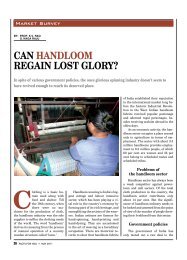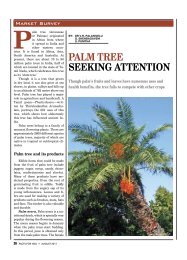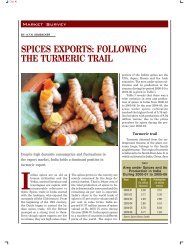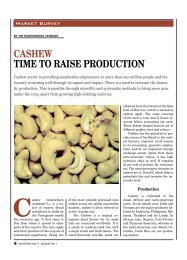DaIry farmIng the rural cash cow - Facts For You
DaIry farmIng the rural cash cow - Facts For You
DaIry farmIng the rural cash cow - Facts For You
You also want an ePaper? Increase the reach of your titles
YUMPU automatically turns print PDFs into web optimized ePapers that Google loves.
Market Survey<br />
production over <strong>the</strong> last ten years<br />
has been about 3.5 million tonnes<br />
per year.<br />
Matters of concern<br />
With higher growth of <strong>the</strong> economy,<br />
increase in population and<br />
increased health consciousness,<br />
it is only natural that <strong>the</strong> demand<br />
for milk and milk products will increase<br />
leading to an increase in<br />
<strong>the</strong> proportion of income spent on<br />
milk and milk products. Fur<strong>the</strong>r,<br />
<strong>the</strong> demand for processed and packaged<br />
dairy products will increase in<br />
<strong>the</strong> urban centres. However, in <strong>rural</strong><br />
areas people may still prefer to<br />
purchase from <strong>the</strong> local milkmen.<br />
About 80 per cent of milk produced<br />
in <strong>the</strong> country is still handled in <strong>the</strong><br />
unorganised sector and only <strong>the</strong><br />
remaining 20 per cent is equally<br />
shared by cooperatives and private<br />
dairies.<br />
Despite <strong>the</strong> growth in milk production<br />
in <strong>the</strong> last six<br />
decades, <strong>the</strong> productivity<br />
of <strong>the</strong> animals is<br />
still low. The marketing<br />
systems are also<br />
not modernised or<br />
developed to a satisfactory<br />
level. O<strong>the</strong>r issues<br />
in this sector are<br />
ineffective breeding<br />
programmes, limited<br />
availability and affordability<br />
of quality feed<br />
and fodder, improper<br />
veterinary infrastructure,<br />
lack of vaccinations,<br />
inadequate access<br />
to formal credit<br />
mechanisms, inadequate<br />
research capacity<br />
and limited processing<br />
capacity.<br />
Considering that<br />
<strong>the</strong> requirement of<br />
milk in 2021-22 is expected<br />
to be 180 million<br />
tonnes and <strong>the</strong><br />
current level of milk production is<br />
112 million tonnes, <strong>the</strong> milk production<br />
must increase at around 5.5 per<br />
cent per annum in <strong>the</strong> next 12 years.<br />
If it fails to do so, India may need<br />
to resort to imports from <strong>the</strong> world<br />
market. A large consumer like India<br />
entering <strong>the</strong> international market<br />
would have <strong>the</strong> potential to cause international<br />
prices to spurt. Hence it<br />
is prudent to depend on <strong>the</strong> domestic<br />
market and develop <strong>the</strong> milk sector<br />
with <strong>the</strong> right attention and focus<br />
and <strong>the</strong> required investment.<br />
Recent hikes in prices of milk and<br />
milk products have been a matter of<br />
concern. The gap between domestic<br />
demand and production of milk has<br />
put upward pressure on milk prices.<br />
Only a strong supply response with<br />
focus on production and productivity<br />
can keep <strong>the</strong> prices stable.<br />
•<br />
The author is assistant professor in department<br />
of economics at Thiruvalluvar<br />
University, Vellore<br />
November 2011 • FACTS FOR YOU 13










